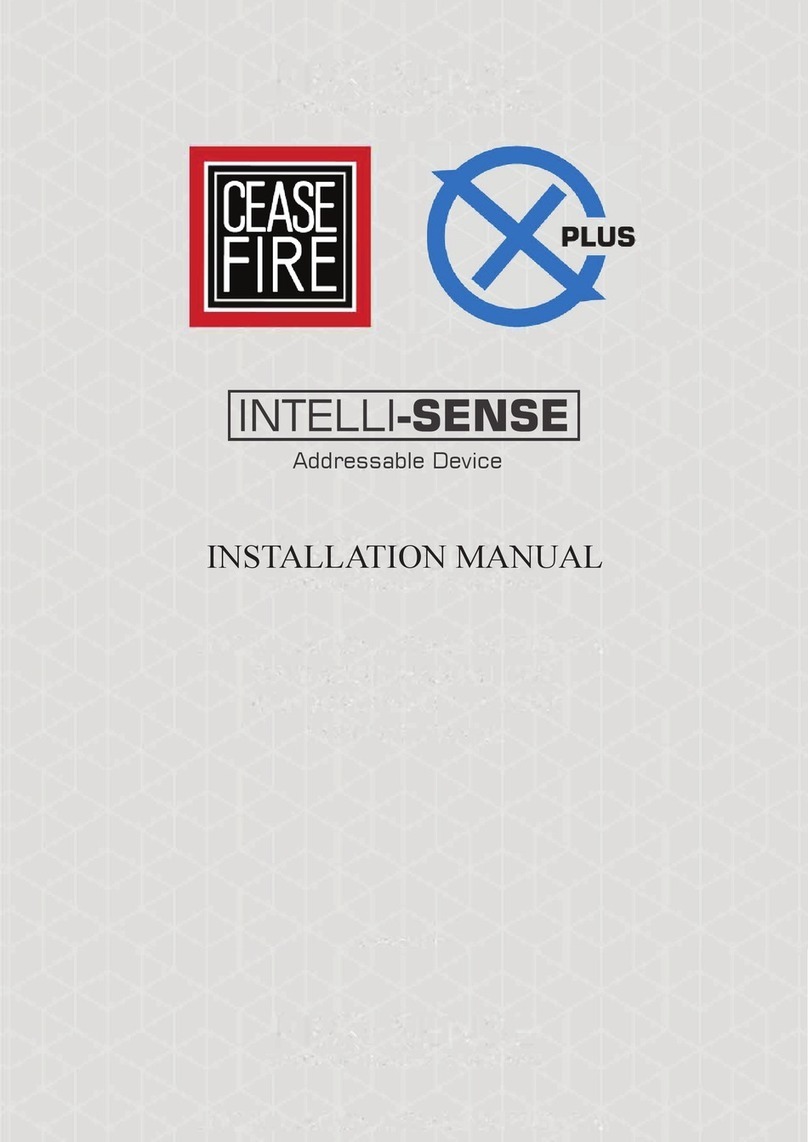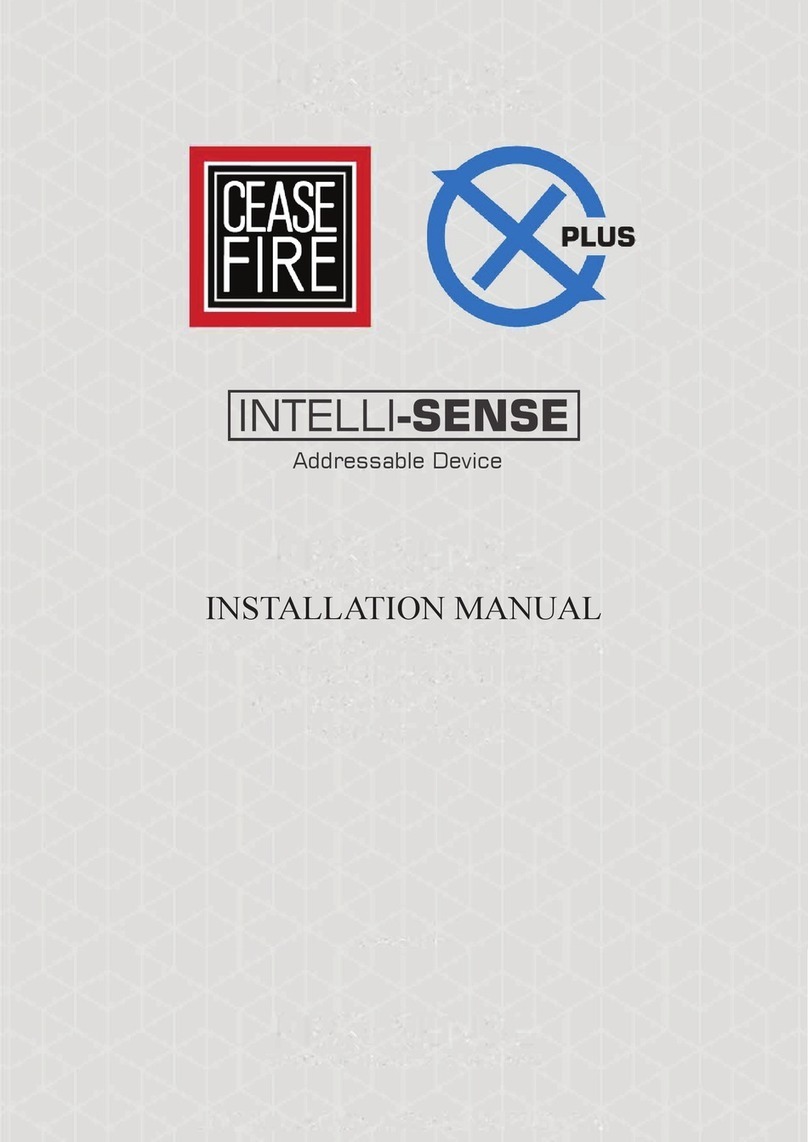WIRING - BASE WITH RESISTOR AND BASE WITH RESITOR AND SCHOTTKY DIODE
This configuration is to be used when the alarm current depends only on the value of the resistor fitted on the base (picture 3).
INSTALLATION
1.Position the detector centrally on its mounting base.
2.Rotate clockwise applying gentle pressure. The detector will drop into its
mechanical holding location.
3.Push the detector to win the force of the contacts.
4.Continue to rotate clockwise a few degrees until the detector is firmly held on
the detector base.
5.When the detector is firmly held verify the alignment between the detector
and the raised marks on the base (picture 5).
6.After installing all detectors, apply power to the fire security system.
7.Test the detectors as described in the paragraph headed “TESTING”.
ANTI -TAMPER MECHANICAL BLOCK FEATURE
The sensor may be blocked onto its base by removing
the small plastic element on the base’s detector
blocking tongue by using a suitable tool (e.g. a small
screwdriver) inserted through the access hole on the
side of the mounting base (picture 4).
To remove the sensor from the base, if mechanically
blocked, insert a suitable tool through the access hole
on the side of the mounting base (picture 4).
TAMPER DETECTION
Each detector’s mounting base has two “–” marked terminals. These are electrically identical, but they are connected to each other
only when a detector is correctly fitted onto the base; this feature is used in combination with an appropriate “end of line” (EOL)
component, designated by the control panel manufacturer, in order to indicate a fault condition if a detector is removed from its
base. To enable the function to operate correctly it is important that incoming and outgoing negative wires are separated in the
above said way.
TESTING
Sensors should be tested after installation and during periodic maintenance visits (it is recommended each device should be tested at
least once per year). When the system has been reset, allow, after each test, at least one minute for power stabilisation before the
next test. Detectors can be tested as follows:
Magnet test
Position the magnet (model TMD-01, optional) next to the sensor between the two raised
marks on the base (picture 5).
The magnet test verifies the function of all electronic circuits of the sensor and its com-
munication with the control panel.
The sensor should trigger an alarm condition on the control panel and turn the red LED
on.
Heat test
Use a hair dryer of 1000-1500 W or an heat tool from an approved manufacturer. Direct
the heat towards the sensor from its side. Hold the heat source at about 15 cm away
from the sensor in order to prevent damage to its cover during testing.
The red LED on the detector should latch into alarm and the control panel should acti-
vate into alarm condition.
If testing fails after installation or maintenance then replace the sensor and return
it for servicing.
MAINTENANCE
Before starting any maintenance work, isolate and disable the system in order to avoid accidental and unwanted fault conditions.
Remove the sensor from its mounting base to allow inspection in good light at ground level. Inspect the sensor’s thermistor area and
use a small, soft bristle brush to dislodge any evident contaminants such as insects, spider webs, hairs, etc. Use a small vacuum
tube or clean, dry and compressed air to suck up or blow away any remaining small particles from the thermistor area. Wipe the
exterior housing of the sensor with a clean, damp, lint free cloth to remove any surface film that can later attract airborne contami-
nants. After all sensors have been inspected, repositioned on their mounting bases and power has been re-applied, check correct
operation as described under the “TESTING” paragraph.
GENERAL DESCRIPTION
TI-002267 and TI-002268 detectors continuously monitor the temperature level and its variation (TI-002268 model only) in the pro-
tected area to provide the earliest warning of fire and offering, at the same time, a high level of false alarm rejection.
These detectors are designed for open area protection and must only be connected to compatible conventional control panels.
The centrally positioned red LED indicator provides 360° visibility, so, during installation, detector orientation is not required.
An inbuilt magnet test feature allows for easy activation in order to verify correct functioning of these detectors on installation site.
TI-002267 model alarms when the environmental temperature reaches a high temperature (see the TECHNICAL SPECIFICATION
table).
This model is used in hot and rapid temperature changing environments.
TI-002268 model alarms when the environmental temperature reaches a relatively “low” temperature (see the TECHNICAL SPECIFI-
CATION table); in addition, a rapid environmental temperature change can trigger an alarm.
IMPORTANT INSTALLATION WARNINGS
CONFIRM YOUR SYSTEM’S COMPATIBILITY BY CONSULTING WITH YOUR SUPPLIER OR WITH THE CONTROL PANEL’S
MANUFACTURER.
FOR SPECIFIC INFORMATION REGARDING DETECTOR AND DEVICE’S SPACING, PLACEMENT AND SPECIAL APPLICA-
TIONS REFER TO YOUR SPECIFIC NATIONAL OR INTERNATIONAL STANDARD CODES OF PRACTICE.
BEFORE INSTALLATION ENSURE THAT POWER IS REMOVED FROM THE SYSTEM.
DURING DEVICE’S CABLING, REMEMBER THAT CONNECTIONS TO THE TERMINALS ARE POLARITY SENSITIVE: SO,
PLEASE, CHECK THEM BY REFERRING TO THE WIRING INFORMATION GIVEN IN THIS MANUAL.
REMEMBER THAT THE ALARM CURRENT ABSORBED BY THE SENSOR MUST BE LIMITED IN ORDER TO AVOID PERMA-
NENT DAMAGE (SEE THE FOLLOWING PARAGRAPHS).
ADAPTOR BASE INSTALLATION
In order to fix a sensor to the wall it is necessary to use its adequate adaptor
base. So:
1) select the position where you
want to install the sensor and the
base.
2) Install the base in the selected
position by inserting the screws in
the points indicated in picture 1.
LIMITATION OF THE ALARM CURRENT
When alarmed, the detector absorbs more current than usually does when quiescent: the absorbed current by the sensor in this state
is indicated as “alarm current”; since:
IF THE ALARM CURRENT EXCEEDS THE MAXIMUM SPECIFIED VALUE (SEE THE TECHNICAL SPECIFICATIONS TABLE),
THE DETECTOR CAN BE PARMANENTLY DAMAGED!
So, the alarm current must be limited in two different ways:
1) having a control panel which limits the alarm current through an in-built limiter.
2) By limiting the alarm current through a resistor fitted on the detector base (see the following wiring paragraphs).
If a remote LED indicator or another remote device is connected to the adaptor base and, so, the sensor, remember that:
ITS ABSORBED CURRENT WILL BE ADDED THE SENSOR’S ALARM CURRENT.
REMOTE OUTPUT CAPABILITY
Remote output capability is available as a standard feature so a remote indication lamp or a compatible platform sounder (check
power requirements) may be wired to the base terminals.
If other equipment is connected to the remote output, its supply current must be eventually limited by using an adequate
resistor. Consult the TECHNICAL SPECIFICATIONS table and assess the external device current absorption’s value.
WIRING - BASE WITHOUT RESISTOR
This configuration is to be used only when the control panel limits the alarm current to less than the sensor’s allowed maximum value
(picture 2).
Picture 3 - Wiring used
when the alarm current
is limited by the resistor
on the mounting base.
Picture 2 - Wiring
used when the
alarm current is
limited by the
control panel.
CAUTION
Dust covers help to protect the devices during
shipping and when first installed. They are not
intended to provide complete protection against
contamination, therefore, sensors should be
removed before construction, major re-decoration
or other dust producing work is started. DUST
COVERS MUST BE REMOVED BEFORE THE
SYSTEM CAN BE MADE OPERATIONAL.
TECHNICAL SPECIFICATIONS *
Power supply 10 - 30 Vdc
Average standby current 90 uA @ 24 V
Maximum allowed alarm current 40 mA (externally limited)
Maximum allowed remote device
current 20 mA (externally limited)
TI-002267 alarm threshold (high
temperature threshold) 78 °C
TI-002268 alarm threshold (low
temperature threshold) 58 °C
Operating temperature range -30 °C / +70 °C
(no condensation)
Humidity 95% RH
(no condensation)
IP rating 40 (42 with base’s water-
proof protection)
CEASEFIRE INDUSTRIES PRIVATE LTD., E6, UPSIDC Industrial area, Selaqui, Dehradun, Pin Code - 248001, Uttarakhand, India
928d/02
L20-S3500-7200 (vA.1)
LINE IN
POSITIVE (+)
LINE IN
NEGATIVE (-)LINE OUT
POSITIVE (+)
LINE OUT
NEGATIVE (-)
REMOTE INDICATOR
END OF LINE RESISTOR
LINE IN
POSITIVE (+)
LINE IN
NEGATIVE (-)LINE OUT
POSITIVE (+)
LINE OUT
NEGATIVE (-)
REMOTE INDICATOR
END OF LINE RESISTOR
Picture 1 - Wall fixing screw entry
points on the adaptor base.
WARNINGS AND LIMITATIONS
Our devices use high quality electronic components and plastic materials that are highly resistant to envi-
ronmental deterioration. However, after 10 years of continuous operation, it is advisable to replace the
devices in order to minimize the risk of reduced performance caused by external factors. Ensure that this
device is only used with compatible control panels. Detection systems must be checked, serviced and
maintained on a regular basis to confirm correct operation.
Smoke sensors may respond differently to various kinds of smoke particles, thus application advice should
be sought for special risks. Sensors cannot respond correctly if barriers exist between them and the fire
location and may be affected by special environmental conditions.
Refer to and follow national codes of practice and other internationally recognized fire engineering stand-
ards.
Appropriate risk assessment should be carried out initially to determine correct design criteria and updated
periodically.
WARRANTY
All devices are supplied with the benefit of a limited 3 years warranty relating to faulty materials or manu-
facturing defects, effective from the production date indicated on each product.
This warranty is invalidated by mechanical or electrical damage caused in the field by incorrect handling or
usage.
Product must be returned via your authorized supplier for repair or replacement together with full infor-
mation on any problem identified.
Full details on our warranty and product’s returns policy can be obtained upon request.
CEASEFIRE INDUSTRIES
PRIVATE LTD.
E6, Upsidc Industrial Area,
Selaqui, Dehradun, Pin
Code-248001, Uttarakhand,
India
19
AU0210CPR
TI-002267
Class B
TI-002268
Class A1R
EN 54-5:2000+A1:2002
For use in compatible fire
detection and alarm system
TI-002267
CONVENTIONAL CLASS B FIXED HEAT DETECTOR
TI-002268
CONVENTIONAL CLASS A1R RATE-OF-RISE HEAT DETECTOR
1. Position the detector.
2. Rotate.
3. Push.
4. Rotate.
Picture 4 - The anti-tamper block and its handling.
Picture 5 - The correctly installed detector.
Magnet
test position
(model TMD-01).
Alignment between base and detector.
*Check latest version of document TDS-S3500 for
further data, obtainable from your supplier.
2831























